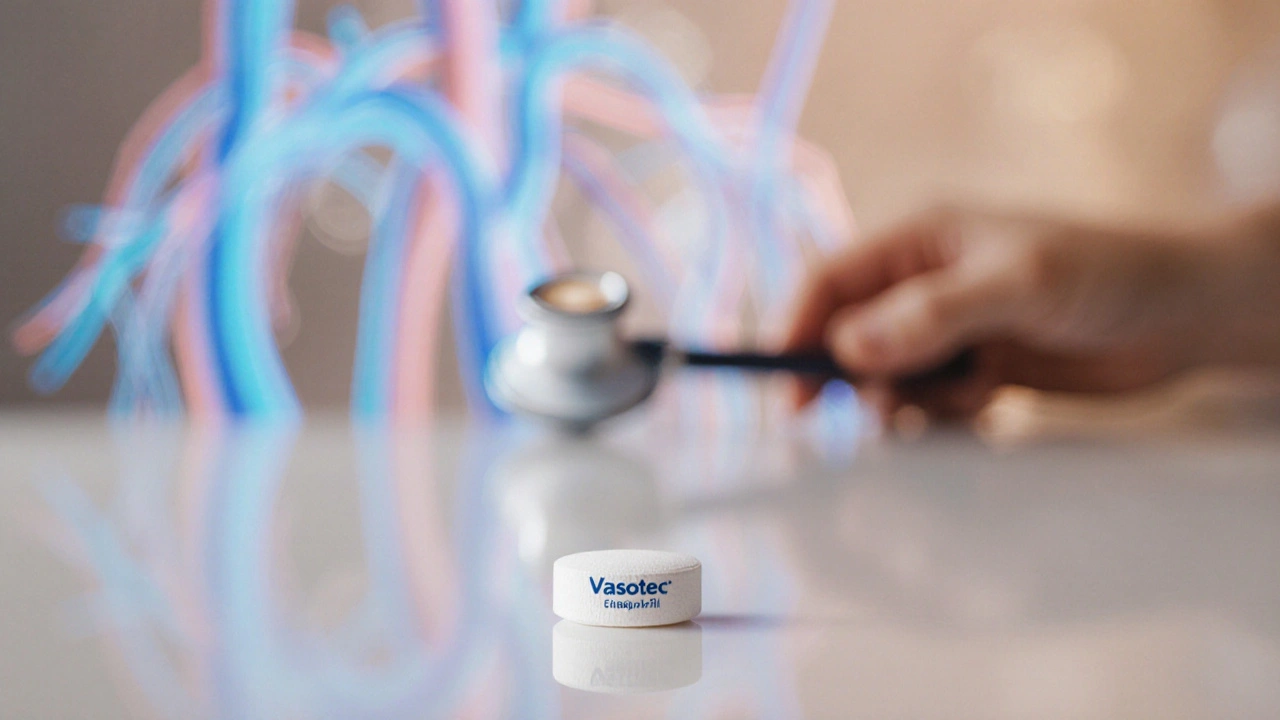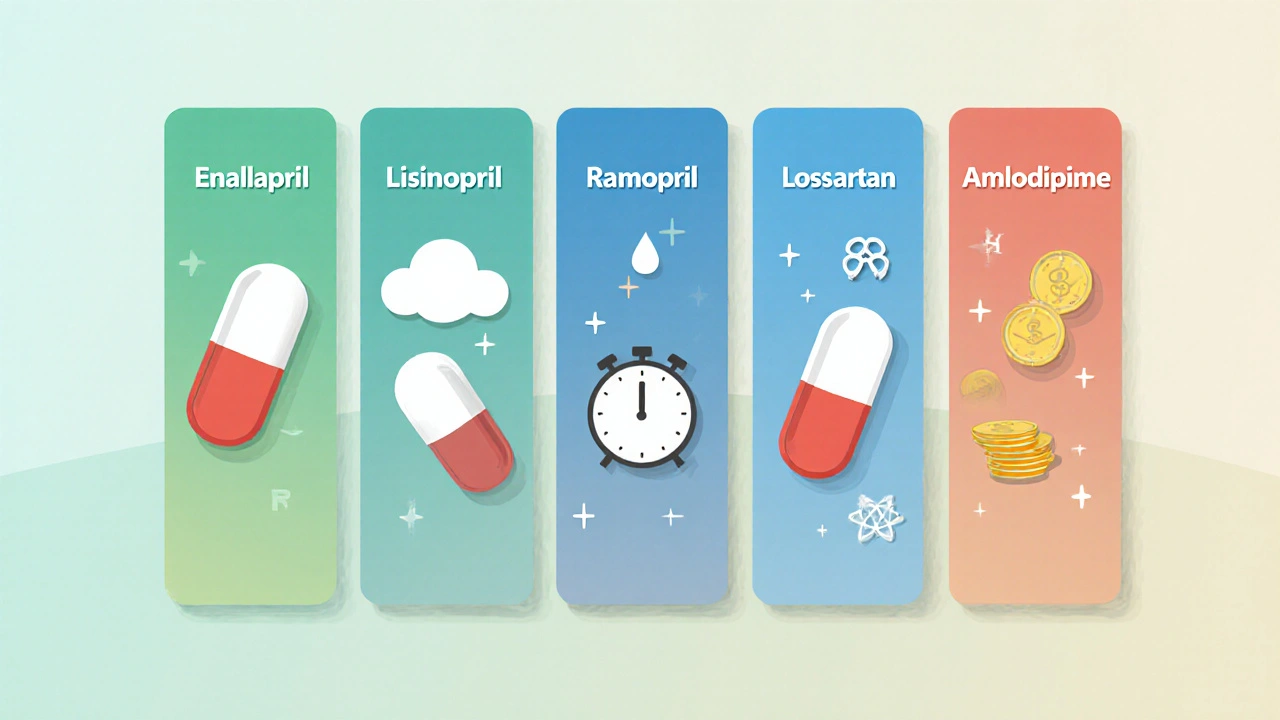Vasotec (Enalapril) vs. Common Blood Pressure Alternatives: A Detailed Comparison
 Oct, 4 2025
Oct, 4 2025
Vasotec (Enalapril) vs. Blood Pressure Alternatives Comparison Tool
Select a medication below to compare its key features with Vasotec (enalapril):
Comparison Results
Key side effects to consider when choosing a medication:
- Dry Cough: Common with ACE inhibitors, rare with ARBs
- Angioedema: Rare but serious, more common with ACE inhibitors
- Hyperkalemia: Elevated potassium levels, especially with potassium-sparing agents
- Dosing Frequency: Most are once daily for convenience
When doctors prescribe a pill for high blood pressure, Vasotec is a brand name you’ll often see. Vasotec is an ACE inhibitor that contains the active ingredient enalapril, which relaxes blood vessels and reduces the workload on the heart. It’s been on the market since the mid‑1990s and is a go‑to choice for many patients with hypertension or heart failure.
Key Takeaways
- Enalapril works by blocking the conversion of angiotensin I to angiotensin II, lowering blood pressure.
- Common alternatives include other ACE inhibitors (lisinopril, ramipril, captopril, benazepril) and ARBs (losartan).
- When choosing a drug, consider side‑effect profile, dosing convenience, kidney function, and cost.
- Enalapril is generally well‑tolerated but can cause cough; switching to an ARB often resolves that.
- Combination therapy (adding a thiazide diuretic or calcium‑channel blocker) can improve control without raising dose.
How Enalapril Works
Enalapril belongs to the ACE inhibitor class. It blocks the enzyme angiotensin‑converting enzyme, preventing the formation of angiotensinII-a potent vasoconstrictor. Without angiotensinII, blood vessels stay relaxed, blood pressure falls, and the heart doesn’t have to pump as hard. The drug also raises bradykinin levels, which contributes to the vasodilatory effect but can also trigger a dry cough in up to 10% of patients.
When Doctors Choose Enalapril
Typical situations include:
- Stage1 or 2 hypertension not controlled by lifestyle changes.
- Heart‑failure patients with reduced ejection fraction.
- Post‑myocardial‑infarction therapy to improve survival.
- Kidney disease where slowing progression is a priority (provided kidney function is adequate).
The usual starting dose is 5mg once daily, titrated up to 20mg based on response and tolerability. It can be taken with or without food, which adds to its convenience.
What to Compare: Decision Criteria
Before you jump to a different pill, line up the factors that matter most:
- Efficacy: Does the drug lower systolic/diastolic pressure by at least 10/5mmHg?
- Side‑effect profile: Frequency of cough, dizziness, hyperkalemia, or angioedema.
- Kidney considerations: Some ACE inhibitors need dose adjustment in chronic kidney disease.
- Convenience: Once‑daily dosing vs. multiple doses.
- Cost & insurance coverage: Generic availability and NHS formulary status.
- Drug interactions: Potassium‑sparing diuretics, NSAIDs, or certain antibiotics.

Top Alternatives to Enalapril
Below are the most frequently prescribed drugs that sit in the same therapeutic space.
Lisinopril
Lisinopril is another ACE inhibitor, often chosen for its long half‑life, which makes once‑daily dosing reliable. It tends to cause a cough at a similar rate to enalapril but is available in a cheap generic form.
Ramipril
Ramipril offers a slightly stronger effect on heart‑failure outcomes and is the ACE inhibitor of choice in many European guidelines for post‑MI patients. Its starting dose is lower (2.5mg), which can be gentler on the stomach.
Captopril
Captopril is the oldest ACE inhibitor and has a short half‑life, requiring two or three doses per day. It’s useful when rapid blood‑pressure control is needed, such as in hypertensive emergencies.
Benazepril
Benazepril is less commonly prescribed but works well for patients who experience cough on other ACE inhibitors. It’s metabolized to benazeprilat, which has a long duration, allowing once‑daily dosing.
Losartan
Losartan belongs to the ARB (angiotensin‑II receptor blocker) class. It blocks the same hormone downstream, offering similar blood‑pressure drops without the cough. It’s a go‑to switch if enalapril’s cough becomes unbearable.
Amlodipine
Amlodipine is a calcium‑channel blocker, not an ACE inhibitor, but doctors often pair it with ACE inhibitors to achieve better control. On its own, it works by relaxing the smooth muscle in arterial walls.
Hydrochlorothiazide
Hydrochlorothiazide (HCTZ) is a thiazide diuretic that reduces fluid volume, lowering blood pressure through a different mechanism. It’s cheap, widely available, and frequently combined with an ACE inhibitor for synergistic effect.
Side‑Effect Comparison Table
| Drug | Cough (dry) | Angioedema | Hyperkalemia | Dosing Frequency | Typical Cost (UK) |
|---|---|---|---|---|---|
| Enalapril | 8‑10% | Rare | Low‑moderate | Once daily | £4‑£6 for 30 tablets |
| Lisinopril | 7‑9% | Rare | Low‑moderate | Once daily | £3‑£5 for 30 tablets |
| Ramipril | 6‑8% | Rare | Low‑moderate | Once daily | £4‑£7 for 30 tablets |
| Losartan | 0% | Very rare | Moderate (monitor K⁺) | Once daily | £5‑£8 for 30 tablets |
| Amlodipine | 0% | Very rare | Low | Once daily | £4‑£6 for 30 tablets |
| Hydrochlorothiazide | 0% | Very rare | Low | Once daily | £1‑£2 for 30 tablets |
Choosing the Right Drug for You
Here’s a quick decision flow you can run through with your GP:
- If you tolerate an ACE inhibitor well and need a single‑pill solution, Enalapril or Lisinopril are solid picks.
- If the dry cough is intolerable, switch to an ARB such as Losartan.
- If you have borderline kidney disease, prefer a drug with less impact on renal function-often an ARB or a lower‑dose ACE inhibitor.
- If you need extra blood‑pressure control, add a thiazide (Hydrochlorothiazide) or a calcium‑channel blocker (Amlodipine).
- Consider cost: generic enalapril and lisinopril are the cheapest ACE options; losartan is slightly pricier but often covered by the NHS.
Always discuss any side‑effects with your doctor. Blood tests for potassium and creatinine help keep the regimen safe.
Potential Pitfalls and How to Avoid Them
- Missing doses: Skipping an ACE inhibitor can cause a rebound rise in blood pressure. Set a daily alarm.
- Pregnancy: ACE inhibitors and ARBs are contraindicated. Switch to methyldopa or labetalol if you become pregnant.
- Drug interactions: NSAIDs can blunt the blood‑pressure‑lowering effect and increase kidney risk. Use acetaminophen when possible.
- Electrolyte imbalance: Monitor potassium if you’re on a potassium‑sparing diuretic or have renal impairment.
Frequently Asked Questions
Can I take Enalapril and Losartan together?
Usually no. Both drugs act on the same hormonal pathway, so combining them can cause excessive blood‑pressure drop and high potassium levels. Your doctor might prescribe a low dose of each only under close monitoring.
Why does Enalapril cause a cough?
Enalapril raises bradykinin in the lungs, which irritates airway nerves and triggers a dry cough. Switching to an ARB typically stops the symptom.
Is it safe to use Enalapril with a diuretic?
Yes, many clinicians pair an ACE inhibitor with a thiazide diuretic (like Hydrochlorothiazide) to boost blood‑pressure control. Just watch potassium and kidney function.
How long does it take for Enalapril to work?
Blood‑pressure reduction can be seen within 2‑4hours, with the full effect reaching a plateau after 2‑3weeks of consistent dosing.
What should I do if I miss a dose?
Take the missed tablet as soon as you remember, unless it’s almost time for the next dose. In that case, skip the missed one and continue with your regular schedule-don’t double‑dose.
Choosing the right blood‑pressure medication isn’t a one‑size‑fits‑all decision. By weighing efficacy, side‑effects, kidney health, and cost, you can land on a regimen that keeps your numbers in check without unwanted annoyances. Use this Enalapril comparison as a roadmap, and always bring the details to your next GP visit.

Halid A.
October 4, 2025 AT 03:19Thank you for the thorough overview; it really helps to see the side‑effect frequencies laid out side by side. The distinction between ACE inhibitors and ARBs is especially useful for patients who develop a persistent cough. I would also add that monitoring potassium levels is crucial when combining these agents with potassium‑sparing diuretics. Cost considerations are always top of mind for many, so the UK pricing gives a solid baseline, though local variations exist. Overall, a solid resource for anyone weighing their options.
Brandon Burt
October 15, 2025 AT 17:06The comparison table is certainly a handy visual aid; however, it doesn't capture the nuanced patient experiences that often dictate medication choice.
For instance, the cough incidence, while numerically modest, can profoundly affect nightly sleep quality, especially for patients already dealing with insomnia.
Moreover, the cost ranges listed are UK‑centric and may not reflect insurance subsidies or generic pricing structures elsewhere, such as in the United States.
It is also worth noting that the hyperkalemia risk, though labeled low‑moderate, can become clinically significant when combined with potassium‑sparing diuretics.
The dosing frequency being once daily is certainly convenient, yet adherence can still falter if patients are not educated about the importance of consistent timing.
In clinical practice, I have observed that patients switched from enalapril to losartan often report immediate relief from the dry cough, confirming the mechanistic link to bradykinin.
Conversely, some individuals on losartan experience subtle peripheral edema, which may be overlooked without diligent monitoring.
The table also omits the rare but serious scenario of angioedema, which, while uncommon, demands emergency attention.
It's essential to interpret the "rare" label with caution, particularly in patients of African descent who may have higher susceptibility.
While the article mentions combination therapy with thiazides, it doesn't discuss the potential for additive potassium disturbances when the thiazide is replaced by a potassium‑sparing agent.
A deeper dive into patient‑reported outcome measures, such as quality‑of‑life scores, often reveals preferences beyond mere blood pressure numbers.
A deeper dive into drug–drug interactions, especially with NSAIDs, would benefit clinicians managing polypharmacy in elderly populations.
Additionally, the impact of renal function on dosing adjustments is a critical consideration that merits explicit mention.
From a pharmacoeconomic perspective, generic enalapril remains one of the most cost‑effective agents, but formulary restrictions can vary dramatically between healthcare systems.
The article's interactive element is a nice touch; however, ensuring accessibility for users with disabilities, such as screen‑reader compatibility, would broaden its utility.
Ultimately, the choice between ACE inhibitors and ARBs should be individualized, weighing efficacy, tolerability, comorbidities, and patient preference in a shared decision‑making process.
Gloria Reyes Najera
October 27, 2025 AT 05:53Look i dont see why anyone would even pick enalapril when losartan has zero cough risk and similar price its just a outdated choice.
Gauri Omar
November 7, 2025 AT 19:39Wow, this analysis hits the mark like a thunderclap!
Imagine a world where you could just flip a switch and decide between a dry cough or a perfectly silent night – that drama is real!
Every line feels like a spotlight on the hidden battles our bodies fight daily, and the table? It's like a battlefield map, guiding us through the fog of choices.
Willy garcia
November 19, 2025 AT 09:26You've laid out the key points nicely and it's clear where the strengths lie for each medication
zaza oglu
November 30, 2025 AT 23:13Oh, what a kaleidoscope of data we have here-vivid, colorful, and brimming with insights!; the way the costs sparkle against the backdrop of efficacy is downright poetic; I love how every statistic dances like fireflies on a summer night; truly a masterpiece for the inquisitive mind!
Vaibhav Sai
December 12, 2025 AT 12:59Great breakdown! The table makes it super easy to compare, and the added notes on cough and kidney considerations are spot‑on; thanks for pulling all this together!
Lindy Swanson
December 24, 2025 AT 02:46Not sure this is needed at all.